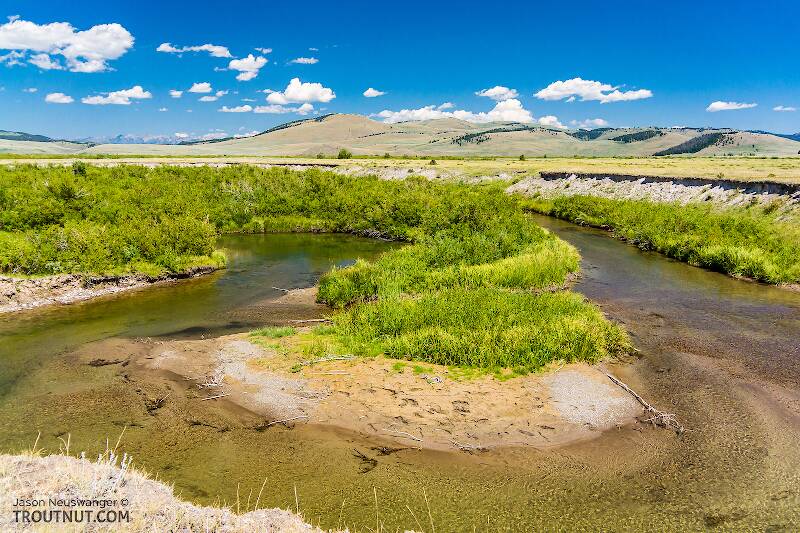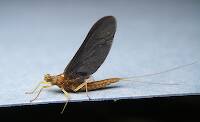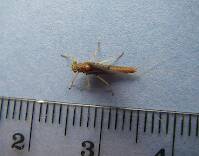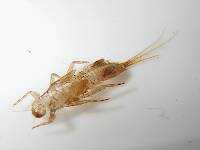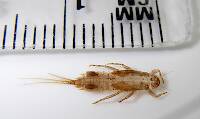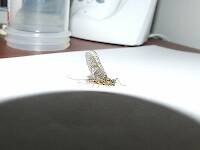
Salmonflies
Pteronarcys californica
The giant Salmonflies of the Western mountains are legendary for their proclivity to elicit consistent dry-fly action and ferocious strikes.
Featured on the forum

I was not fishing, but happened to be at an unrelated social event on a hill above this tiny creek (which I never even saw) when this stonefly flew by me. I assume it came from there. Some key characteristics are tricky to follow, but process of elimination ultimately led me to Sweltsa borealis. It is reassuringly similar to this specimen posted by Bob Newell years ago. It is also so strikingly similar to this nymph from the same river system that I'm comfortable identifying that nymph from this adult. I was especially pleased with the closeup photo of four mites parasitizing this one.

Troutnut is a project started in 2003 by salmonid ecologist Jason "Troutnut" Neuswanger to help anglers and
fly tyers unabashedly embrace the entomological side of the sport. Learn more about Troutnut or
support the project for an enhanced experience here.
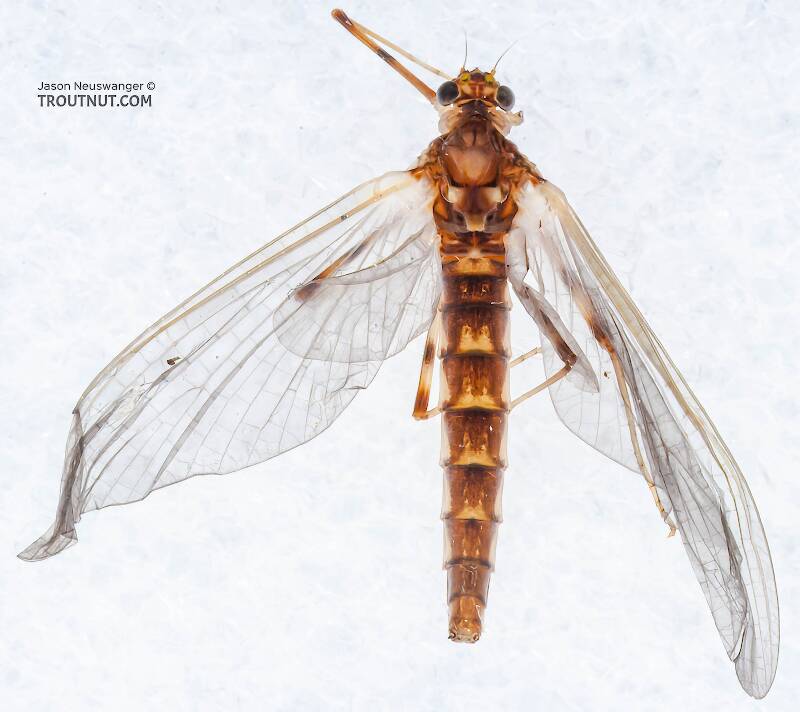
This specimen is really strange, very different in form from any other mayfly I've seen. Unfortunately it was found alone crippled in an eddy and in pretty bad shape, and I couldn't find any others like it.
Taxon on Jul 19, 2019July 19th, 2019, 7:10 pm EDT
Hi Jason-
I believe this female to be a spinner, rather than a dun, and is probably Spinadus simplex.
I believe this female to be a spinner, rather than a dun, and is probably Spinadus simplex.
Troutnut on Jul 20, 2019July 20th, 2019, 3:21 am EDT
Hi Roger,
That's an interesting guess and certainly seems to match the general body profile well. However, the color patterns on both the tergites and sternites are very different from those in the Spinadis simplex specimen you uploaded to bugguide.net earlier this year:
https://bugguide.net/node/view/1634542/bgimage
Another page on there led to this paper describing the first adult of Spinadis simplex:
http://www.ephemeroptera-galactica.com/pubs/pub_m/pubmccaffertyw1984p173.pdf
This characteristic seems especially relevant in the description of S. simplex, and doesn't seem to match this specimen: "The fore tibia is approximately three times as long as the tarsus, and one-third the length of the femur."
Another important one is, "The hind tibia is 1.16 times the femur length." They note this is also present to some extent in the nymphs.
Also, the shape of the subanal plate is pretty different and is noted as a valuable characteristic.
The paper also extensively describes the characteristics of an enlarged pronotum in S. simplex that doesn't seem to be present in this one.
Finally, the habitat is very different; this came from a smalls stream distant from any of the large rivers previously described as Spinadis habitat.
I still think this is a dun -- the wings are quite pale for a dun but not really hyaline like a spinner. My early photography didn't make this particularly easy to tell, but you can also make out setae on the margins of the wings in this picture.
The dun-spinner difference might explain some other differences including the leg proportions, but I think enough characteristics differ that it's probably not S. simplex.
That's an interesting guess and certainly seems to match the general body profile well. However, the color patterns on both the tergites and sternites are very different from those in the Spinadis simplex specimen you uploaded to bugguide.net earlier this year:
https://bugguide.net/node/view/1634542/bgimage
Another page on there led to this paper describing the first adult of Spinadis simplex:
http://www.ephemeroptera-galactica.com/pubs/pub_m/pubmccaffertyw1984p173.pdf
This characteristic seems especially relevant in the description of S. simplex, and doesn't seem to match this specimen: "The fore tibia is approximately three times as long as the tarsus, and one-third the length of the femur."
Another important one is, "The hind tibia is 1.16 times the femur length." They note this is also present to some extent in the nymphs.
Also, the shape of the subanal plate is pretty different and is noted as a valuable characteristic.
The paper also extensively describes the characteristics of an enlarged pronotum in S. simplex that doesn't seem to be present in this one.
Finally, the habitat is very different; this came from a smalls stream distant from any of the large rivers previously described as Spinadis habitat.
I still think this is a dun -- the wings are quite pale for a dun but not really hyaline like a spinner. My early photography didn't make this particularly easy to tell, but you can also make out setae on the margins of the wings in this picture.
The dun-spinner difference might explain some other differences including the leg proportions, but I think enough characteristics differ that it's probably not S. simplex.
Jason Neuswanger, Ph.D.
Troutnut and salmonid ecologist
Troutnut and salmonid ecologist
Quick Reply
Related Discussions
Topic
Replies
Last Reply
2
Nov 12, 2020
by Troutnut
by Troutnut
19
Oct 8, 2010
by PaulRoberts
by PaulRoberts
Re: Puzzled on this mayfly, not even confident on family
In Male Rhithrogena hageni Mayfly Spinner by Troutnut
In Male Rhithrogena hageni Mayfly Spinner by Troutnut
1
Jul 23, 2019
by Millcreek
by Millcreek
0
May 3, 2007
by Troutnut
by Troutnut
7
May 9, 2012
by Entoman
by Entoman
Re: Help to get some specimens of the isopod Caecidotea communis
In the Arthropod Family Asellidae by Leonardo
In the Arthropod Family Asellidae by Leonardo
11
Mar 29, 2013
by Leonardo
by Leonardo

